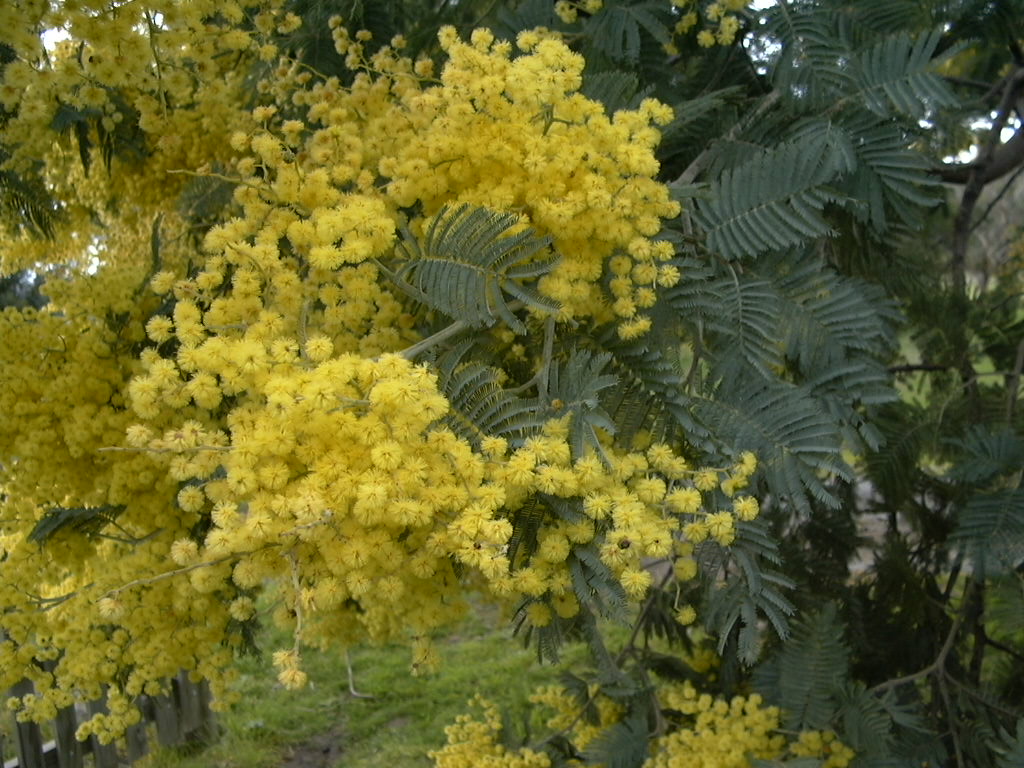Wattle seed from Silver Wattle Acacia dealbata has the most fabulous flavour. This flavour depends on your palette, you may think it tastes similar to coffee, chocolate, hazelnut or something in between. The seed is ready to harvest when the pods are a rusty-purple colour and just starting to split open. This happens at Christmas time, which is really inconvenient in the holiday season, but it's well worth the effort of harvesting. You can pick bunches quite readily, or place a tarp below the tree and let if fall by itself while you skip off to the beach. The ripe seed is incredibly hard, and needs to be put through a grinder until it's fine, with the appearance of instant coffee.
Silver Wattle is known as a pioneer plant as it comes up first in disturbed ground, which has been damaged by heavy machinery, fire, over-grazing or floods along rivers and streams. As it's such a prolific plant, some see it as a threat and needs to be controlled. However Silver Wattle doesn't like to be controlled, and will put up a major resistance, trying harder to carry out its important job. Due to its rapid growth from seed. Silver Wattle's job is to hold the soil after disturbance and fix nitrogen in the soil. This allows other slower species to take advantage of the soil conditions and grow under the protection of the wattle trees. Although at first, we only see the lush growth of Silver Wattle, if we look closer we will find many different species sheltering underneath.
Silver Wattle is a common and prolific tree in Tasmania but is much maligned for being short lived. Silver Wattle generally for being short lived. Silver Wattles generally live for about 25 years and then die naturally, replaced by longer lived trees such as Eucalypts, but in that time, they have provided many functions and their benefits are enormous.
The Silver Wattle flowers are prolific, covering the whole tree in a blaze of yellow pom-pom flowers. These flowers are rich in pollen, high in protein, fats and other nutrients. So, if you are a bird lover you will see many parrots including the red and green rosellas gorging on pollen. The acacia flowers also attract many insects which in turn attracts insectivorous birds such as thornbills and silvereyes. bees also love the rich pollen, as do hoverflies, butterflies, moths and beetles. When Silver Wattles are flowering it's a pollinators picnic. And of course, we benefit from these pollinator's for our vegetables, fruit trees and other crops.
Silver Wattle is well known for its beautiful bluish green foliage and the flowers are often used in floral arrangements. It is also prized for its timber, similar to blackwood, but lighter and with more pink colouring. It is easy to work, with both machine and hand tools. It may be turned, bored, sawed and planed with excellent results. Pre-drilling is recommended to prevent splitting. Silver Wattle is also an excellent bending timber. It glues satisfactorily with most adhesives, accepts most finishes readily, and may be polished to a smooth, lustrous surface. Silver Wattle is not recommended for external applications including decorative, architectural and structural use.
So, from seed to timber, this is one tree worth including in your plantings. Silver Wattle is truly a wonderful wattle.
Silver Wattle is known as a pioneer plant as it comes up first in disturbed ground, which has been damaged by heavy machinery, fire, over-grazing or floods along rivers and streams. As it's such a prolific plant, some see it as a threat and needs to be controlled. However Silver Wattle doesn't like to be controlled, and will put up a major resistance, trying harder to carry out its important job. Due to its rapid growth from seed. Silver Wattle's job is to hold the soil after disturbance and fix nitrogen in the soil. This allows other slower species to take advantage of the soil conditions and grow under the protection of the wattle trees. Although at first, we only see the lush growth of Silver Wattle, if we look closer we will find many different species sheltering underneath.
Silver Wattle is a common and prolific tree in Tasmania but is much maligned for being short lived. Silver Wattle generally for being short lived. Silver Wattles generally live for about 25 years and then die naturally, replaced by longer lived trees such as Eucalypts, but in that time, they have provided many functions and their benefits are enormous.
The Silver Wattle flowers are prolific, covering the whole tree in a blaze of yellow pom-pom flowers. These flowers are rich in pollen, high in protein, fats and other nutrients. So, if you are a bird lover you will see many parrots including the red and green rosellas gorging on pollen. The acacia flowers also attract many insects which in turn attracts insectivorous birds such as thornbills and silvereyes. bees also love the rich pollen, as do hoverflies, butterflies, moths and beetles. When Silver Wattles are flowering it's a pollinators picnic. And of course, we benefit from these pollinator's for our vegetables, fruit trees and other crops.
Silver Wattle is well known for its beautiful bluish green foliage and the flowers are often used in floral arrangements. It is also prized for its timber, similar to blackwood, but lighter and with more pink colouring. It is easy to work, with both machine and hand tools. It may be turned, bored, sawed and planed with excellent results. Pre-drilling is recommended to prevent splitting. Silver Wattle is also an excellent bending timber. It glues satisfactorily with most adhesives, accepts most finishes readily, and may be polished to a smooth, lustrous surface. Silver Wattle is not recommended for external applications including decorative, architectural and structural use.
So, from seed to timber, this is one tree worth including in your plantings. Silver Wattle is truly a wonderful wattle.

 RSS Feed
RSS Feed